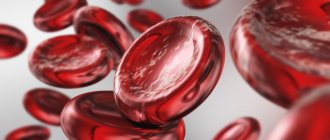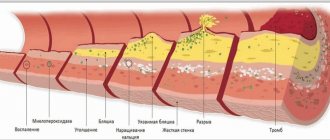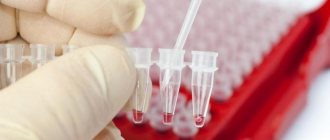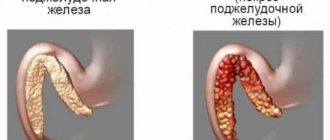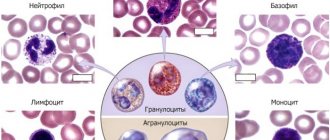- Types of blood tests
- General clinical blood test
- Due date and how to prepare
- Metrics collected
- Decoding the results: norm and deviation
- When to take it
- Blood chemistry
- Due date and how to prepare
- Metrics collected
- Decoding the results: norm and deviation
- When to take it
- Immunological blood test
- Due date and how to prepare
- Metrics collected
- Decoding the results: norm and deviation
- When to take it
- Hormonal blood test
- Due date and how to prepare
- Metrics collected
- Decoding the results: norm and deviation
- When to take it
- Serological blood test
- Due date and how to prepare
- Serological blood test methods
- What is the result of a serological blood test?
- When to take it
- How and where to get a blood test
Blood is taken for analysis in order to determine the state of the body and its functionality, identify organ diseases, hormonal imbalances, lack of vitamins and nutrients, find out about the presence of viruses and infections, inflammatory processes and other diseases. Blood is also taken to monitor the progress of pregnancy and to identify its group and Rh factor.
Types of blood tests
There are 5 main types of blood tests:
- General clinical blood test
, which is carried out as part of a general clinical examination of the patient. Allows you to assess your overall health and identify a number of problems that will require further diagnosis. - A biochemical blood test
allows you to analyze the functioning of internal organs, metabolism, metabolism and the body’s need for trace elements and vitamins; - Immunological blood test
- detects viral, infectious, oncological and allergic diseases; - A hormonal blood test
allows you to determine the level of hormones and draw conclusions about the correct functioning of the thyroid gland, pituitary gland, adrenal glands, genital organs and others. - A serological blood test
shows the stage of the infectious process.
Each test examines a number of blood parameters in a laboratory setting. Depending on the purpose of the study, the maximum number of parameters or a small part that is important for identifying violations is studied. Based on the results of the analysis, the patient receives a table with blood parameters and their values, which are then deciphered by the doctor, prescribe additional tests and make a diagnosis.
In addition, there are other tests, for example, blood type and Rh factor. This information is important for serious illnesses such as blood transfusions and organ transplants.
Micronutrients for the hematopoietic system
Hematopoiesis - that is, hematopoiesis - is a set of stages in the transformation of a stem cell into one of the elements that make up the blood. Let us repeat that the role of vitamins B6, B9 and B12 and iron in these processes is a priority, and jumps in hct levels always one way or another lead to the conclusion about a lack of these substances.
In addition to these four, attention should be paid to other nutritional compounds.
- Vitamin E is a fat-soluble form and can accumulate in any tissue, but mainly in fat. Protects red blood cell membranes from damage due to oxidative stress;
- Vitamin C – adds iron to the process of hemoglobin synthesis, starting with the formation of red blood cells in the red bone marrow;
- Vitamin A (retinol) – helps transfer iron from “reserves”;
- Vitamin B2 (riboflavin) – helps not to remove the necessary iron prematurely through the genitourinary system;
- Vitamin D2 (ergocalciferol) - helps transport iron from storage cells to the red bone marrow, where hemoglobin is produced in the red blood cell;
- Copper - helps iron oxidize to the level of digestibility (ferrous);
- Omega 3 and Omega 6 fatty acids stimulate and regulate the formation of new cells in the process of erythropoiesis (the formation of red blood cells).
Often, if hct tests are questionable, you can turn to an additional blood test for vitamins and microelements that are involved in hematopoiesis. Based on detailed data, we can talk about developing a personal complex of micronutrients that will meet the needs within the framework of the individual characteristics of the body.
General clinical blood test
It is carried out as part of a general clinical examination of the patient and allows you to learn about the condition of the blood and the body as a whole. The main indicators of this analysis are: hemoglobin, the number of leukocytes (white blood cells), erythrocytes (red blood cells) and platelets (nuclear-free plates of blood responsible for clotting).
Due date and how to prepare
A general blood test is taken in the morning on an empty stomach, often from a finger, less often from a vein. You should not drink or eat 4 hours before the test.
Metrics collected
Now a general blood test is carried out on automatic hematological analyzers, which can simultaneously determine values from 5 to 24 parameters.
The main indicators collected are:
- Hemoglobin (HGB - hemoglobin)
- the main component that is involved in the transfer of oxygen in the blood from the lungs to organs and tissues, and carbon dioxide back to the lungs, is the blood pigment of red blood cells. - Red blood cells (RBC - red blood cells)
are red blood cells that carry oxygen in the blood to organs and tissues. - Leukocytes (WBC - white blood cells)
are white blood cells produced in the bone marrow that carry out immune control and protect the body from foreign cells. - Thrombocytes (PLT - platelets)
are nuclear-free platelets of blood responsible for clotting. - Lymphocytes (LYM - lymphocyte)
are cells of the immune system that respond to viruses and microbes. - Monocytes (MON - monocyte)
are large cells of the immune system. - Hematocrit (HCT - hematocrit)
is the volume of red blood cells in the blood. - Blood color index (BI)
, demonstrating the concentration of hemoglobin in red blood cells. - Erythrocyte sedimentation rate
, which, if deviated from the norm, may indicate a pathological condition of the body. - Various erythrocyte, leukocyte and platelet indices
.
Decoding the results: norm and deviation
The normal values of the blood parameters studied in each laboratory are different and depend on the gender, age and condition of the patient. Only a doctor can make a correct interpretation of the blood test results and make a diagnosis, taking into account all aspects of the patient’s health. Below are frequently examined blood parameters, their normal values, and what a deviation from the norm may indicate in the general case, and not in the specific case. To obtain an individual interpretation and diagnosis, you should consult a doctor.
Hemoglobin (HGB - hemoglobin)
Normal hemoglobin level in blood:
Men:
- from 12 to 15 years: 120 - 160 g/l;
- from 15 to 18 years: 117 - 166 g/l;
- from 18 to 45 years: 132 - 173 g/l;
- from 45 to 65 years: 131 - 172 g/l;
- over 65 years old: 126 - 174 g/l.
Women:
- from 12 to 15 years: 115 - 150 g/l;
- from 15 to 18 years: 117 - 153 g/l;
- from 18 to 45 years: 117 - 155 g/l;
- from 45 to 65 years: 117 - 160 g/l;
- over 65 years old: 120 - 161 g/l.
Children:
- up to 2 weeks: 134 - 198 g/l;
- from 2 to 4.3 weeks: 107 - 171 g/l;
- from 4.3 to 8.6 weeks: 94 - 130 g/l;
- from 8.6 weeks to 4 months: 103 - 141 g/l;
- at 4 to 6 months: 111 - 141 g/l;
- from 6 to 9 months: 114 - 140 g/l;
- from 9 to 1 year: 113 - 141 g/l;
- from 1 year to 5 years: 100 - 140 g/l;
- from 5 years to 10 years: 115 - 145 g/l;
- from 10 to 12 years: 120 - 150 g/l;
Deviation of hemoglobin in the blood from the norm may indicate:
when decreasing by:
- overhydration - increased water content in the body due to impaired water-salt metabolism;
- anemia - disruption of the oxygen transport function in the body and the development of hypoxia.
when increasing by:
- dehydration - loss of water in the body;
- polycythemia vera - increased blood viscosity and decreased blood flow;
- excessive smoking.
Red blood cells (RBC - red blood cells)
Norm of red blood cells in the blood:
Men:
- from 12 - 18 years: 4.5 - 5.3 * 10^12/l;
- over 18 years old: 4.0 - 5.0 * 10^12/l.
Women:
- from 12 - 18 years: 4.1 - 5.1 * 10^12/l;
- over 18 years old: 3.5 - 4.7 * 10^12/l.
Children:
- newborn: 3.9 - 5.5 * 10^12/l;
- from 1 to 3 days: 4.0 - 6.6 * 10^12/l;
- in 1 week: 3.9 - 6.3 * 10^12/l;
- in week 2: 3.6 - 6.2 * 10^12/l;
- at 1 month: 3.0 - 5.4 * 10^12/l;
- in the 2nd month: 2.7 - 4.9 * 10^12/l;
- from 3 to 6 months: 3.1 - 4.5 * 10^12/l;
- from 6 months to 2 years: 3.7 - 5.3 * 10^12/l;
- from 2 to 6 years: 3.9 - 5.3 * 10^12/l;
- from 6 to 12 years: 4.0 - 5.2 * 10^12/l.
Normal erythrocyte indices:
- MCV
: 80 - 95 fl - average erythrocyte volume; - MCH
: 27 - 31 pg - average hemoglobin content in an individual red blood cell; - MCHC
: 320 - 360 g/l - average hemoglobin concentration in the erythrocyte mass; - RDW
: 11.5% - 14.5% - red blood cell distribution width; - RDW-SD
: 37 - 54 fl - deviation of the distribution of red blood cells by volume; - RDW-CV
: 11.5 - 14.5% (adults), 14.9 - 18.7% (children up to 6 months) and 11.6 - 14.8% (children over 6 months) - deviation of red blood cell size from averages; - P-LCR
: 13 - 43% - large platelet ratio; - ESR
: 10 mm/hour (men), 15 mm/hour (women) - erythrocyte sedimentation rate, deviation of which from the norm may indicate a pathological or inflammatory process in the body.
Deviation of red blood cells from the norm may indicate:
when decreasing by:
- anemia;
- blood loss;
- pregnancy;
- overhydration;
- decrease in the intensity of red blood cell formation in the bone marrow;
- therapy with diuretics;
- accelerated destruction of red blood cells.
when increasing by:
- burn;
- diarrhea;
- hydrocele of the renal pelvis;
- true polycythemia;
- Cushing's syndrome;
- neoplasms;
- steroid use;
- the effect of corticosteroids;
- taking diuretics.
Leukocytes (WBC - white blood cells)
Norm of leukocytes in the blood:
Men and women:
- from 16 years and older: 4.0 - 9.0 * 10^9/l.
Children:
- up to 1 year: 6.0 - 17.5 * 10^9/l;
- from 1 year to 2 years: 6.0 - 17.0 * 10^9/l;
- from 2 to 4 years: 5.5 - 15.5 * 10^9/l;
- from 4 to 6 years: 5.0 - 14.5 * 10^9/l;
- from 6 to 10 years: 4.5 - 13.5 * 10^9/l;
- from 10 to 16 years: 4.5 - 13.0 * 10^9/l.
Norm of leukocyte indices:
- LYM% (LY%)
: 25 - 40% - relative content of lymphocytes; - LYM# (LY#)
: 1.2 - 3.0 * 10^9/l (1.2-3.0 x 10^3/μl) - absolute lymphocyte content; - MXD% (MID%)
: 5 - 10% - the relative content of a mixture of monocytes, eosinophils and basophils; - MXD# (MID#)
: 0.2 - 0.8 * 10^9/l - absolute content of a mixture of monocytes, eosinophils and basophils; - NEUT% (NE%)
: 40% - 75% - relative content of neutrophils; - NEUT# (NE#)
: 2 - 7.5 * 10^9/l - absolute content of neutrophils; - MON% (MO%)
: 4 - 11% - relative content of monocytes; - MON# (MO#)
: 0.1 - 0.6 * 10^9 cells/l - absolute content of monocytes; - EO%
: 1 - 5% - relative content of eosinophils; - EO#
: 0.4 * 109/l - absolute eosinophil content; - BA%
: less than 1% - relative content of basophils; - BA#
: 0 - 0.08 * 10^9/l - absolute content of basophils; - IMM%
: 1 - 5% - relative content of immature granulocytes; - IMM#
: 1.2 - 6.8 * 10^9/l - absolute content of immature granulocytes; - ATL%
: less than 5% - the relative content of atypical lymphocytes; - ATL#
: 0.06 - 0.15 * 10^9/l - absolute content of atypical lymphocytes; - GR% (GRAN%)
: 47 - 72% - relative content of granulocytes; - GR# (GRAN#)
: 1.2 - 6.8 * 10^9/l (1.2 - 6.8 * 10^3/μl) - absolute granulocyte content.
Deviation of leukocytes in the blood from the norm may indicate:
when decreasing by:
- typhus;
- viral diseases;
- bone marrow diseases and damage;
- anaphylactic shock;
- leukemia;
- viral diseases;
- radiation sickness;
- Addison-Biermer disease;
- collagenosis;
- myelodysplastic syndromes;
- hypersplenism;
- myelofibrosis;
- plasmacytoma;
- taking certain antibiotics and anti-inflammatory drugs;
- anemia.
when increasing by:
- the presence of inflammatory processes in the body;
- sepsis;
- purulent processes;
- tissue injuries;
- myocardial infarction;
- infectious diseases;
- the presence of malignant neoplasms;
- last trimester of pregnancy;
- period of feeding the baby with breast milk;
- great physical activity.
Thrombocytes (PLT - platelets)
Normal platelet count in blood:
Men, women and children:
- all ages - 180 - 320 * 10^9 cells/l.
Normal platelet indices:
- MPV (mean platelet volume): 7 - 10 fL - average platelet volume;
- PDW: 9 - 16% - width of platelet distribution by volume;
- PCT (platelet crit): 0.108 - 0.282% - the proportion of blood volume occupied by platelets.
Deviation of platelets in the blood from the norm may indicate:
when decreasing by:
- bronchial asthma;
- malaria;
- thrombocytopenia;
- malignant neoplasm;
- Sumter's syndrome.
when increasing by:
- essential thrombocythemia
Lymphocytes (LYM - lymphocyte)
Norm of lymphocytes in the blood:
Men and women:
- from 16 years and older: 20 - 40%.
Children:
- newborns: 15 - 35%;
- up to 2 weeks: 22 - 55%;
- from 2 weeks to 1 year: 45 - 70%;
- from 1 year to 2 years: 37 - 60%;
- from 2 to 5 years: 33 - 55%;
- from 6 to 7 years: 30 - 50%;
- from 8 to 9 years: 30 - 50%;
- from 9 to 11 years: 30 - 46%;
- from 12 to 15 years: 30 - 45%.
Deviation of lymphocytes in the blood from the norm may indicate:
when decreasing by:
- autoimmune diseases;
- diseases of the nervous system;
- HIV infection;
- side effects from taking medications.
when increasing by:
- viral diseases;
- bacterial infections;
- fungal diseases;
- toxoplasmosis;
- tuberculosis;
- whooping cough;
- vasculitis;
- malignant neoplasms;
- initial stage of HIV;
- excess carbohydrates in the body compared to fats and proteins;
- thyroid diseases;
- starvation.
Monocytes (MON - monocyte)
Norm of monocytes in the blood:
Men and women:
- from 16 years and older: 3 - 9%.
Children:
- newborns: 3 - 12%;
- up to 2 weeks: 5 - 15%;
- from 2 weeks to 1 year: 4 - 10%;
- from 1 year to 2 years: 3 - 10%;
- from 2 to 5 years: 3 - 9%;
- from 6 to 7 years: 3 - 9%;
- from 8 to 9 years: 3 - 9%;
- from 9 to 11 years: 3 - 9%;
- from 12 to 15 years: 3 - 9%.
Deviation of monocytes in the blood from the norm may indicate:
when decreasing by:
- use of immunosuppressants;
- hereditary diseases.
when increasing by:
- stress;
- diabetes;
- atherosclerosis;
- bacterial infections;
- malignant neoplasms;
- sepsis;
- collagenosis;
- sarcoidosis
Hematocrit (HCT - hematocrit)
Hematocrit norm:
Men:
- from 12 to 15 years: 35 - 45%;
- from 15 to 18 years: 37 - 48%;
- from 18 to 45 years old: 42 - 50%;
- from 45 to 65 years: 39 - 50%;
- over 65 years old: 37 - 51%.
Women:
- from 12 to 15 years: 34 - 44%;
- from 15 to 18 years: 34 - 44%;
- from 18 to 45 years old: 38 - 47%;
- from 45 to 65 years: 35 - 47%;
- over 65 years old: 35 - 47%.
Children:
- up to 2 weeks: 41 - 65%;
- from 2 to 4.3 weeks: 33 - 55%;
- from 4.3 to 8.6 weeks: 28 - 42%;
- from 8.6 weeks to 4 months: 32 - 44%;
- from 4 to 6 months: 31 - 41%;
- from 6 to 9 months: 32 - 40%;
- from 9 to 12 months: 33 - 41%;
- from 1 year to 3 years: 32 - 40%;
- from 3 to 6 years: 32 - 42%;
- from 6 to 9 years: 33 - 41%;
- from 9 to 12 years: 34 - 43%.
A hematocrit deviation from the norm may indicate:
when decreasing by:
- pregnancy;
- anemia;
- children's age;
- hypoproteinemia;
- overhydration.
when increasing by:
- true polycythemia;
- hypoxia;
- kidney hydronephrosis;
- kidney neoplasm;
- polycystic kidney disease;
- peritonitis;
- burn disease;
- leukemia;
- dehydration.
Blood color index (BC)
Normal blood color index:
Men, women and children:
- all ages: 0.9 - 1.1.
A deviation of the blood color indicator from the norm may indicate:
when decreasing by:
- anemia;
- purulent infections;
- cirrhosis of the liver;
- tuberculosis;
- Iron-deficiency anemia;
- iron-saturated hypochromia;
- malignant neoplasms;
- thalassemia;
- microcytosis.
when increasing by:
- lack of vitamin B12;
- lack of folic acid;
- dysbacteriosis;
- chronic pancreatitis;
- stomach diseases;
- diseases of the small intestine;
- cirrhosis of the liver;
- long-term treatment with glucose-lowering drugs;
- long-term treatment with anti-tuberculosis drugs;
- poor nutrition.
When to take it
A general clinical blood test must be taken:
- As prescribed by a doctor;
- As a preventative measure to assess general health;
- As part of routine medical examinations and examinations.
Increased hematocrit
An increase in hematocrit occurs with an increase in the number of blood cells - polycythemia - and a lack of fluid in the body. An increase in the indicator may indicate serious diseases accompanied by blood thickening and thrombotic complications.
Causes
Hematocrit increases due to stress, taking corticosteroid drugs and diuretics, traumatic shock accompanied by intense pain, as well as when climbing to high altitudes, smoking, or playing sports using anabolic steroids to gain muscle mass.
An increase in the indicator may indicate the following diseases:
- dehydration due to vomiting, profuse diarrhea, overheating or heat stroke, excessive sweating, insufficient fluids;
- heavy bleeding in the midst or immediately after it stops;
- pathologies accompanied by a decrease in blood plasma volume, for example, peritonitis, thrombosis, diabetes, burn disease;
- renal dysfunction - hydronephrosis, oncology, polycystic disease;
- vitamin B12 or iron deficiency anemia;
- leukemia;
- erythrocytosis;
- defects and coronary heart disease, heart failure;
- intestinal obstruction;
- bronchial asthma, pulmonary emphysema, obstructive bronchitis.
Symptoms
An increase in blood viscosity leads to thrombus formation. The latter can manifest itself in the form of tingling or various pains and numbness in the limbs. If the cause of increased blood viscosity is not determined in time, serious complications such as myocardial infarction, stroke, gangrene and even death may develop.
Treatment
Treatment is carried out not for the changed hematocrit level itself, but for the conditions or diseases that caused these changes. In some situations, when serious causes for a slightly changed hematocrit level have been excluded, no treatment is required. But usually such situations are short-lived, in the case of physiological reasons for changes in hematocrit levels.
Blood chemistry
A laboratory blood test that gives an idea of the condition of internal organs and their functionality. Allows you to evaluate metabolism and find out about the lack of microelements in the body.
Due date and how to prepare
A biochemical blood test is taken in the morning on an empty stomach from a vein. You should not eat 12 hours before the test. You can only drink clean water, but drinks, including tea, coffee and any others, are not allowed. 24 hours before the test you must give up alcohol, smoking and physical activity.
Metrics collected
- Glucose
- blood sugar level; - Urea
is a parameter important for assessing kidney function; - Cholesterol
is an element that determines the risk of cardiovascular diseases; - LDL cholesterol
is an element that determines the risk of cardiovascular disease; - HDL cholesterol
is an element that determines the risk of cardiovascular disease; - Residual blood nitrogen
is a parameter important for assessing kidney function; - Atherogenicity coefficient (Ka)
- shows the risk of developing atherosclerosis; - Total bilirubin
is an indicator that may indicate the presence of jaundice; - Total protein
is an indicator that allows you to evaluate liver function; - AST (AST)
is an indicator that allows you to evaluate the work of the heart; - AlAt (ALT)
is an indicator that allows you to evaluate liver function; - Lipase
is an indicator that allows you to evaluate the functioning of the pancreas; - Amylase
is an indicator that allows you to evaluate the functioning of the pancreas; - Gamma-GTP
is an indicator that allows you to evaluate liver function; - Antistreptolysin-O
is an indicator that is used in the diagnosis of rheumatism; - Rheumatic factor
is an indicator that is used in the diagnosis of autoimmune diseases; - CRP (C-reactive protein)
is an indicator that can indicate inflammation in the body; - Alkaline phosphatase
is an indicator of many different diseases and health problems; - Albumin
is a protein that performs many functions in the body; - General lipids
are fats that perform structural and regulatory functions in the body; - Triglycerides
are fats that perform structural and energy functions in the body; - Phospholipids
- an indicator that assesses the metabolism of fats in the body, indicating liver and kidney diseases, and indirectly diabetes mellitus; - Protein fractions
are indicators that may indicate inflammatory processes, infectious and other diseases in the body; - Calcium
is an important element for the nervous and cardiovascular systems; - Potassium
is an element that normalizes heart rhythm and regulates water balance; - Sodium
is an element that regulates the volume of extracellular fluid; - Chlorine
is an element that regulates the acid-base balance of the blood; - Iron
is an element important for binding, transporting and transmitting oxygen throughout the body.
Decoding the results: norm and deviation
The normal values of the blood parameters studied in each laboratory are different and depend on the gender, age and condition of the patient. Only a doctor can make a correct interpretation of the blood test results and make a diagnosis, taking into account all aspects of the patient’s health. Below are frequently examined blood parameters, their normal values, and what a deviation from the norm may indicate in the general case, and not in the specific case. To obtain an individual interpretation and diagnosis, you should consult a doctor.
Glucose
Norm
: 3.33 - 6.38 millimoles per liter;
Deviation
: May indicate diabetes mellitus or hypoglycemia.
Urea
Norm
: 2.5 - 8.3 millimoles per liter;
Deviation
: May indicate a kidney problem.
Cholesterol
Norm
: 3.6 mmol/l - 7.8 mmol/l;
Deviation
: may indicate obesity, endocrine disorders, genetic diseases and others.
LDL cholesterol (bad cholesterol)
Norm
: 2.02 - 4.79 mmol/l (men), 1.92 - 4.51 mmol/l (women);
Deviation
: Excess may indicate liver disease, kidney disease, obesity and other diseases.
HDL cholesterol (good cholesterol)
Norm
: 0.72 - 1.63 mmol/l (men), 0.86 - 2.28 mmol/l (women);
Deviation
: A decrease may indicate various diseases and poor nutrition.
Residual blood nitrogen
Norm
: 14.3 - 28.6 mmol/l;
Deviation
: May indicate a kidney problem.
Atherogenic coefficient (Ka)
Norm
: 14.3 - 28.6 mmol/l;
Deviation
: May indicate a kidney problem.
Total bilirubin
Norm
: 8.5 - 20.55 µmol/liter;
Deviation
: May indicate liver problems and jaundice.
Total protein
Norm
: 48 - 73 grams per liter (newborns), 47 - 72 grams per liter (children up to one year old), 61 - 75 grams per liter (from 1 to 4 years), 52 - 78 grams per liter (from 5 to 7 years) , 58 - 76 grams per liter (from 8 to 15 years), 65 - 85 grams per liter (adults);
Deviation
: May indicate liver problems or nutritional deficiencies.
AsAt (AST)
Norm
: 10 - 38 IU/l;
Deviation
: May indicate problems with the heart.
AlAt (ALT)
Norm
: 7 - 41 IU/l;
Deviation
: May indicate liver problems.
Lipase
Norm
: 0 - 190 units per 1 ml of blood (adults), 0 - 130 units per 1 ml of blood (children);
Deviation
: may indicate problems with the pancreas.
Amylase
Norm
: less than 53 U/l;
Deviation
: may indicate problems with the pancreas.
Gamma-GTP
Norm
: 15 - 106 µmol/l (men), 10 - 66 µmol/l (women);
Deviation
: may indicate problems with the liver and a number of other diseases.
Antistreptolysin-O
Norm
: less than 200 units;
Deviation
: May indicate rheumatism.
Rheumatic factor
Norm
: less than 14 IU/ml;
Deviation
: May indicate autoimmune diseases.
CRP (C-reactive protein)
Norm
: 0 - 10 mg/l;
Deviation
: May indicate inflammation in the body.
Alkaline phosphatase
Norm
: 20 - 140 IU/l;
Deviation
: Can indicate many different diseases and health problems.
Albumen
Norm
: 35 - 52 g/l;
Deviation
: Can indicate many different diseases and health problems.
General lipids
Norm
: 4 - 8 g/l;
Deviation
: Can indicate many different diseases, aging and diets.
Triglycerides
Norm
: 0 - 2.25 mmol/l;
Deviation
: may indicate pathology of internal organs.
Phospholipids
Norm
: 2.52 - 2.91 mmol/l;
Deviation
: may indicate liver and kidney diseases, and indirectly diabetes mellitus.
Protein fractions
Norm
: total protein 65 - 85 g/l;
Deviation
: may indicate inflammatory processes, infectious and other diseases in the body.
Calcium
Norm
: 2.15 - 2.50 mmol/l;
Deviation
: can lead to diseases of the nervous and cardiovascular systems and others.
Potassium
Norm
: 3.5 - 5.5 mmol/l;
Deviation
: can lead to diseases of the cardiovascular, muscular system and others.
Sodium
Norm
: 136 - 145 mmol/l;
Deviation
: may indicate a malfunction of the kidneys, liver, endocrine system and other body systems.
Chlorine
Norm
: 98 - 107 mmol/l;
Deviation
: may indicate metabolic disorders and other diseases.
Iron
Norm
: 8.95 - 30.43 µmol/l;
Deviation
: Can lead to disruption of various body functions.
When to take it
A biochemical blood test must be taken:
- As prescribed by a doctor;
- As part of routine medical examinations and examinations;
- To assess the functioning of internal organs and the functionality of the body;
- To determine the need for microelements;
- For information about metabolism;
- After suffering from infectious or somatic diseases.
Decreased hematocrit
A decreased hematocrit occurs when the number of red blood cells or their size decreases - erythrocytopenia. The cause may also be the accumulation of water in the body when the blood becomes thinner - hyperhydration, as well as hyperproteinemia or the accumulation of proteins in the plasma, which contributes to fluid retention.
Causes
A decrease in hematocrit is facilitated by prolonged immobility, fasting or a strict diet, taking anticoagulants and antiplatelet agents, and intravenous infusions in large volumes; heavy drinking, chronic alcoholism, excessive salt intake, menstruation in women.
Also, a downward change in the indicator may indicate the following pathologies:
- iron-, B12- or folate-deficiency anemia;
- severe bleeding;
- impaired hemoglobin production in sickle cell anemia;
- fibrous degeneration of the liver - cirrhosis;
- disruption of the urinary system;
- hemolysis of erythrocytes - destruction of red blood cells due to hereditary mutation, autoimmune processes or toxic effects on blood cells;
- malaria, typhoid fever;
- oncological diseases of the bone marrow or its metastatic lesions from other organs;
- an increase in the amount of protein in plasma due to vomiting, diarrhea, blood cancer and other conditions.
During pregnancy, a decrease in hematocrit can be observed in the case of toxicosis, a very young age of the mother, multiple pregnancies, a short period of time between pregnancies, and also after the 20th week of gestation due to a physiological increase in fluid in the body.
Symptoms
A decrease in hematocrit in the blood is accompanied by hypoxia of various organs, since it is the red blood cells that normally carry oxygen throughout the body. This condition is manifested by the following symptoms:
- fast fatiguability;
- general weakness;
- drowsiness;
- increased heart rate and breathing;
- feeling of lack of air;
- headache, dizziness;
- decreased memory and concentration;
- hair loss;
- marbling or pallor of the skin.
Immunological blood test
A laboratory blood test that examines blood serum obtained by centrifugation. The presence and level of antibodies are detected in the serum to determine infectious diseases, allergies, parasitic infestations, autoimmune diseases, immunodeficiency states of the body and neoplasms. An immunological blood test detects infections such as syphilis, chlamydia, mycoplasma, ureaplasma, trichomonas, gonorrhea, herpes, HIV, AIDS, measles, hepatitis, cytomegalovirus, mumps, toxoplasmosis, rubella, coronaviruses, COVID-19 and many others.
Due date and how to prepare
An immunological blood test is taken in the morning on an empty stomach from a vein. You should not eat 12 hours before the test. Avoid alcoholic drinks for 3 days. Avoid solariums and x-rays for 2 days. Don't stress in 1 day. No smoking for 1 hour. You should not do the test during menstruation.
Metrics collected
General indicators of immunological blood test:
- Subpopulations of lymphocytes
are different types of white blood cells that recognize various foreign structures, altered body cells and produce antibodies to destroy them. The indicators of this group give a general idea of the state of immunity. - Immunoglobulins
- various types of antibodies, the purpose of which is to destroy infections and toxins. The presence of certain antibodies in the blood indicates the infections they are fighting against. Main types of immunoglobulins:- A (IgA)
- responsible for the immunity of mucous membranes; - M (IgM)
- responsible for the body’s primary defense reaction; - G (IgG)
- responsible for the main fight against infections that have entered the body; - E (IgE)
and
D (IgD)
- responsible for the fight against parasites and allergens.
Decoding the results: norm and deviation
The normal values of the blood parameters studied in each laboratory are different and depend on the gender, age and condition of the patient. Only a doctor can make a correct interpretation of the blood test results and make a diagnosis, taking into account all aspects of the patient’s health. Below are frequently examined blood parameters, their normal values, and what a deviation from the norm may indicate in the general case, and not in the specific case. To obtain an individual interpretation and diagnosis, you should consult a doctor.
Lymphocyte subpopulations
Norm of lymphocyte subpopulation for adults:
- T-lymphocytes (CD3+)
: 0.8 - 2.2 * 10^9/l (60 - 80%); - Ratio CD3+CD4+ / CD3+CD8+
: 1,0 — 2,5; - NK cells (CD3-CD16/56+)
: 6 — 20%; - % activated T-cytotoxic lymphocytes (CD3+CD8+HLA-DR+)
: 3 — 19%; - T-cytotoxic lymphocytes (CD3+CD8+)
: 0.3 - 0.9 * 10^9/l; - CD3+CD4+CD8+
: less than 3%; - % activated T helper cells (CD3+CD4+HLA-DR+)
: 2 — 9%; - T-helpers (CD3+CD4+)
: 0.5 - 1.4 * 10^9/l; - % activated T lymphocytes (CD3+HLA-DR+)
: 3 — 10%; - CD3+CD4-CD8
: less than 7%; - T-cytotoxic lymphocytes (CD3+CD8+)
: 19 — 35%; - % cytolytic T lymphocytes (CD3+CD16/56+)
: 0 — 10%; - B lymphocytes (CD19+)
: 7 — 19%; - NK cells (CD3-CD16/56+)
: 0.1 - 0.4 * 10^9/l; - B-lymphocytes (CD19+)
: 0.1 - 0.4 * 10^9/l; - T helper cells (CD3+CD4+)
: 33 — 52%.
An abnormal lymphocyte subpopulation may indicate:
- autoimmune diseases;
- viral infections;
- bacterial infections;
- neoplasms;
- poisoning;
- radioactive exposure;
- other health problems.
Immunoglobulin A (IgA)
Norm:
- 0.6-4.5 g/l.
Deviation of A (IgA) from the norm may indicate:
when decreasing by:
- toxic poisoning;
- cirrhosis of the liver;
- radiation sickness.
when increasing by:
- arthritis;
- inflammatory processes in the liver.
- multiple myeloma;
- glomerulonephritis;
- skin diseases;
- diseases of the digestive system;
- respiratory tract diseases.
Immunoglobulin M (IgM)
Norm:
- 0.25 - 2.5 g/l.
Deviation of M (IgM) from the norm may indicate:
when decreasing by:
- poisoning;
- immunosuppressants in the body;
- radiation sickness.
when increasing by:
- viral or bacterial infections;
- parasites;
- autoimmune processes.
Immunoglobulin G (IgG)
Norm:
- 5.4 - 18.22 g/l.
Deviation of G (IgG) from the norm may indicate:
when decreasing by:
- poisoning;
- cirrhosis of the liver;
- immunosuppressants;
- radiation sickness.
when increasing by:
- viral diseases;
- bacterial diseases;
- fungal diseases;
- poisoning by toxins.
Immunoglobulin E (IgE) and D (IgD)
Norm:
- E (IgE)
: 0 - 100 IU/ml; - D (IgD)
: 0 to 0.07 g/l.
Deviation of E (IgE) and D (IgD) from the norm may indicate:
when decreasing by:
- immunodeficiency;
- immunosuppressants.
when increasing by:
- parasites;
- allergies.
When to take it
An immunological blood test must be taken:
- As prescribed by a doctor;
- If you suspect a viral or bacteriological infection in the body;
- If you suspect an allergy;
- If neoplasms are suspected;
- If a fungal infection is suspected;
- If parasites are suspected.
The value of normal hematocrit in humans
The body of a healthy adult contains approximately 4.5-5 liters of blood. It contains formed elements and cells - red blood cells, platelets, leukocytes, as well as a liquid part called plasma.
Some blood components, for example, red blood cells, do not have all the necessary components of a human cell, losing them during the maturation process. Therefore, red blood cells and platelets are called blood cells, not cells.
In different categories of patients, the normal values of various parameters of the blood tested will differ. So, for most men, the hematocrit will be higher: 40-41%, and in some cases it can reach up to 51%, which is due to its slower renewal.
In healthy women, the hematocrit usually ranges from 36 to 42%. This is due to physiological features - due to regular menstrual bleeding, blood is renewed more often to replenish its volume. During pregnancy, from the 20th week, the indicator begins to decrease, which is also not considered a deviation.
In children, hematocrit differs at different age periods:
- 44-62% for newborns;
- 32-43% for babies up to three months;
- 36-43% for children under one year of age;
- 35-47% (up to 52% for boys) - in the first ten years.
In subsequent years, the hematocrit norm depends on gender and practically corresponds to the values of an adult.
Hormonal blood test
A laboratory blood test, which is carried out to study the functioning of the endocrine system and identify diseases of the thyroid gland, pituitary gland, adrenal glands, genital organs and others.
Due date and how to prepare
A hormonal blood test is taken in the morning on an empty stomach from a vein. 1 day before the test you need to give up smoking, alcohol and physical activity. 7 days before this test, you must stop taking hormonal medications. In women, blood is taken for hormonal analysis on days 5-7 of the cycle, counting from the first day of menstruation.
Metrics collected
Thyroid hormones:
- T3 (triiodothyronine);
- T4 (thyroxine);
- Antibodies to thyroglobulin (AT-TG).
Sex hormones:
- Testosterone (male sex hormone);
- Estrogens (female sex hormones).
Pituitary hormones:
- TSH (thyroid stimulating hormone);
- FSH (follicle stimulating hormone);
- LH (luteinizing hormone);
- Prolactin;
- ACTH (adrenocorticotropic hormone).
Adrenal hormones:
- DEA-s (dehydroepiandrosterone sulfate);
- Aldosterone;
- Cortisol.
When planning pregnancy:
- FSH (follicle stimulating hormone)
- responsible for the growth of the egg; - LH (luteinizing hormone)
- ensures completion of egg maturation; - Prolactin
- stimulates milk production after childbirth; - Estradiol
- affects all female genital organs; - Progesterone (pregnancy signaling hormone)
- produced after the egg matures and is important for the proper course of pregnancy; - DEA-sulfate (DEA-s or DEAS)
.
Decoding the results: norm and deviation
The normal values of the blood parameters studied in each laboratory are different and depend on the gender, age and condition of the patient. Only a doctor can make a correct interpretation of the blood test results and make a diagnosis, taking into account all aspects of the patient’s health. Below are frequently examined blood parameters, their normal values, and what a deviation from the norm may indicate in the general case, and not in the specific case. To obtain an individual interpretation and diagnosis, you should consult a doctor.
Thyroid hormones
Thyroid hormone levels:
- T3 (triiodothyronine)
: 2.6 - 5.7 pmol/l; - T4 (thyroxine)
: 0.7-1.48 ng/dl; - Antibodies to thyroglobulin (AT-TG)
: 0-4.11 U/ml.
Abnormalities in thyroid hormones may indicate:
- thyroid diseases;
- autoimmune diseases.
Sex hormones
Normal sex hormones:
- Testosterone (male sex hormone)
: 4.94 - 32.01 nmol/l (men), 0.38 - 1.97 nmol/l (women); - Estrogens (female sex hormones): progesterone
: 1st phase of the menstrual cycle - 1.0 - 2.2 nM/l; 2nd phase of the menstrual cycle - 23.0 - 30.0 nM/l; for postmenopause - 1.0 - 1.8 nM/l; - estradiol
: 1st phase of the menstrual cycle - 198 - 284 pM/l: 2nd phase of the menstrual cycle - 439 - 570 pM/l; for postmenopause - 51 - 133 pM/l.
Deviations from the norm of sex hormones may indicate:
- diseases of the genital organs;
- adrenal neoplasms;
- cirrhosis of the liver.
Pituitary hormones
Norm of pituitary hormones:
- TSH (thyroid-stimulating hormone)
: 0.4-4.0 mU/l; - FSH (follicle-stimulating hormone)
: 1.37 - 13.58 mU/ml (men), 0.57 - 8.77 mU/ml (women); - LH (luteinizing hormone)
: 1.26 - 10.05 mU/ml (men), 0.61 to 56.6 mU/ml (women); - Prolactin
: 2.58 - 18.12 ng/ml (men), 1.2 - 29.93 ng/ml (women); - ACTH (adrenocorticotropic hormone)
: 9-52 pg/ml.
Deviations from the norm of pituitary hormones may indicate:
- pituitary diseases;
- dysfunction of the thyroid gland;
- stress;
- pregnancy and breastfeeding;
- other conditions.
Adrenal hormones
Normal levels of adrenal hormones:
- DEA-s (dehydroepiandrosterone sulfate)
: 3591-11907 nmol/l (men), 810-8991 nmol/l (women); - Aldosterone
: 35 - 350 pg/ml; - Cortisol
: 3.7-19.4 mcg/dl.
Abnormalities in adrenal hormones may indicate:
- adrenal gland diseases;
- stress;
- hunger;
- other conditions.
Hormones when planning pregnancy
Normal hormone levels when planning pregnancy:
- FSH (follicle-stimulating hormone)
: 0.57 – 8.77 mU/ml; - LH (luteinizing hormone)
: 1 - 96.0 mIU/ml; - Prolactin
: 64 - 395 mIU/l; - Estradiol
: 57 - 426 ng/l; - Progesterone (pregnancy signaling hormone)
: 0.2 to 1.5 ng/ml; - DEA-sulfate (DEA-s or DEAS)
: 810-8991 nmol/l (women).
Deviations from normal hormones when planning pregnancy may indicate:
- pregnancy;
- diseases of the genital organs;
- other diseases.
When to take it
You need to take a hormonal blood test:
- when prescribed by a doctor;
- when planning pregnancy;
- to control the course of pregnancy;
- if you suspect hormonal disorders;
- with unreasonable weight gain;
- with an enlarged thyroid gland.
Serological blood test
A laboratory blood test that involves the interaction of antibodies and antigens. It is carried out to identify infectious diseases and the stage of the infectious process.
Due date and how to prepare
A hormonal blood test is taken in the morning on an empty stomach from a vein.
Serological blood test methods
- To confirm the diagnosis, an antigen corresponding to the suspected disease is added to the blood serum, and if there is a reaction, then there are antibodies to the disease and the patient is sick.
- To determine the type of infection, antibodies of the expected type are added to the serum, and if there is a reaction, then there is an infection in the blood that corresponds to the added antibodies.
What is the result of a serological blood test?
The analysis provides an answer to whether there is a suspected infection in the human body.
When to take it
- when prescribed by a doctor;
- if you suspect a certain infection;
- to prescribe the correct treatment.
Indications
The appointment of an OAC, which includes a hematocrit study, is included in the standard patient examination plan and is mandatory:
- when undergoing a medical examination and/or medical examination;
- if any disease is detected or suspected by a clinic doctor;
- in preparation for planned surgery;
- during hospitalization (on the day of admission and on the eve of discharge).
Calculation of the hematocrit number is required for certain indications;
- blood clotting disorder;
- dehydration (dehydration);
- assessment of the degree of anemia (anemia), polycythemia (increase in blood cells);
- bleeding.


